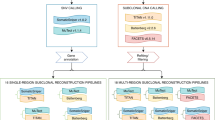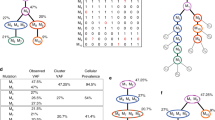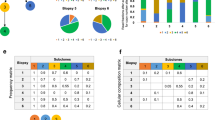Abstract
Subclonal architectures are prevalent across cancer types. However, the temporal evolutionary dynamics that produce tumor subclones remain unknown. Here we measure clone dynamics in human cancers by using computational modeling of subclonal selection and theoretical population genetics applied to high-throughput sequencing data. Our method determined the detectable subclonal architecture of tumor samples and simultaneously measured the selective advantage and time of appearance of each subclone. We demonstrate the accuracy of our approach and the extent to which evolutionary dynamics are recorded in the genome. Application of our method to high-depth sequencing data from breast, gastric, blood, colon and lung cancer samples, as well as metastatic deposits, showed that detectable subclones under selection, when present, consistently emerged early during tumor growth and had a large fitness advantage (>20%). Our quantitative framework provides new insight into the evolutionary trajectories of human cancers and facilitates predictive measurements in individual tumors from widely available sequencing data.
This is a preview of subscription content, access via your institution
Access options
Access Nature and 54 other Nature Portfolio journals
Get Nature+, our best-value online-access subscription
$29.99 / 30 days
cancel any time
Subscribe to this journal
Receive 12 print issues and online access
$209.00 per year
only $17.42 per issue
Buy this article
- Purchase on Springer Link
- Instant access to full article PDF
Prices may be subject to local taxes which are calculated during checkout





Similar content being viewed by others
Change history
18 July 2018
In the version of this article originally published, in the “Theoretical framework of subclonal selection” section of the main text, ref. 11 instead of ref. 19 should have been cited at the end of the phrase “Our previously presented frequentist approach to detect subclonal selection from bulk sequencing data involves an R2 test statistic.” The error has been corrected in the HTML and PDF versions of the article.
References
Greaves, M. & Maley, C. C. Clonal evolution in cancer. Nature 481, 306–313 (2012).
Gay, L., Baker, A.-M. & Graham, T. A. Tumor cell heterogeneity. F1000Res 5, 238 (2016).
McGranahan, N. & Swanton, C. Clonal heterogeneity and tumor evolution: past. Cell 168, 613–628 (2017).
Burrell, R. A. & Swanton, C. Re-evaluating clonal dominance in cancer evolution. Trends Cancer 2, 263–276 (2016).
Hartl, D. L. & Clark, A. G. Principles of Population Genetics. (Sinauer Associates, Inc.: Sunderland, MA, USA, 1997).
Marjoram, P. & Tavaré, S. Modern computational approaches for analyzing molecular-genetic-variation data. Nat. Rev. Genet. 7, 759–770 (2006).
Fu, Y. X. & Li, W. H. Estimating the age of the common ancestor of a sample of DNA sequences. Mol. Biol. Evol. 14, 195–199 (1997).
Tavaré, S., Balding, D. J., Griffiths, R. C. & Donnelly, P. Inferring coalescence times from DNA sequence data. Genetics 145, 505–518 (1997).
Tsao, J. L. et al. Colorectal adenoma and cancer divergence. Evidence of multilineage progression. Am. J. Pathol. 154, 1815–1824 (1999).
Tsao, J. L. et al. Genetic reconstruction of individual colorectal tumor histories. Proc. Natl Acad. Sci. USA 97, 1236–1241 (2000).
Williams, M. J., Werner, B., Barnes, C. P., Graham, T. A. & Sottoriva, A. Identification of neutral tumor evolution across cancer types. Nat. Genet. 48, 238–244 (2016).
Sun, R. et al. Between-region genetic divergence reflects the mode and tempo of tumor evolution. Nat. Genet. 49, 1015–1024 (2017).
Durrett, R. Branching Process Models of Cancer. (Springer: New York, 2015).
Bozic, I. et al. Accumulation of driver and passenger mutations during tumor progression. Proc. Natl Acad. Sci. USA 107, 18545–18550 (2010).
Cheek, D. & Antal, T. Mutation frequencies in a birth–death branching process. Preprint at https://arxiv.org/abs/1710.09783 (2017).
Kessler, D. A. & Levine, H. Scaling solution in the large population limit of the general asymmetric stochastic Luria–Delbrück evolution process. J. Stat. Phys. 158, 783–805 (2015).
Durrett, R. Population genetics of neutral mutations in exponentially growing cancer cell populations. Ann. Appl. Probab. 23, 230–250 (2013).
Nik-Zainal, S. et al. The life history of 21 breast cancers. Cell 149, 994–1007 (2012).
Levy, S. F. et al. Quantitative evolutionary dynamics using high-resolution lineage tracking. Nature 519, 181–186 (2015).
Gillespie, J. H. Genetic drift in an infinite population. The pseudo-hitchhiking model. Genetics 155, 909–919 (2000).
Wu, C.-I., Wang, H.-Y., Ling, S. & Lu, X. The ecology and evolution of cancer: the ultra-microevolutionary process. Annu. Rev. Genet. 50, 347–369 (2016).
Toni, T. & Stumpf, M. P. H. Simulation-based model selection for dynamical systems in systems and population biology. Bioinformatics 26, 104–110 (2010).
Honda, O. et al. Doubling time of lung cancer determined using three-dimensional volumetric software: comparison of squamous cell carcinoma and adenocarcinoma. Lung Cancer 66, 211–217 (2009).
Peer, P. G., van Dijck, J. A., Hendriks, J. H., Holland, R. & Verbeek, A. L. Age-dependent growth rate of primary breast cancer. Cancer 71, 3547–3551 (1993).
Tilanus-Linthorst, M. M. A. et al. BRCA1 mutation and young age predict fast breast cancer growth in the Dutch, United Kingdom and Canadian magnetic resonance imaging screening trials. Clin. Cancer Res. 13, 7357–7362 (2007).
Griffith, M. et al. Optimizing cancer genome sequencing and analysis. Cell Syst. 1, 210–223 (2015).
Zhang, J. et al. Intratumor heterogeneity in localized lung adenocarcinomas delineated by multi-region sequencing. Science 346, 256–259 (2014).
Alexandrov, L. B. et al. Signatures of mutational processes in human cancer. Nature 500, 415–421 (2013).
The Cancer Genome Atlas Network. Comprehensive molecular characterization of human colon and rectal cancer. Nature 487, 330–337 (2012).
Wang, K. et al. Whole-genome sequencing and comprehensive molecular profiling identify new driver mutations in gastric cancer. Nat. Genet. 46, 573–582 (2014).
Jamal-Hanjani, M. et al. Tracking the evolution of non-small-cell lung cancer. N. Engl. J. Med. 376, 2109–2121 (2017).
Robinson, D. R. et al. Integrative clinical genomics of metastatic cancer. Nature 548, 297–303 (2017).
Lässig, M., Mustonen, V. & Walczak, A. M. Predicting evolution. Nat. Ecol. Evol. 1, 77 (2017).
Shah, S. P. et al. The clonal and mutational evolution spectrum of primary triple-negative breast cancers. Nature 486, 395–399 (2012).
Merkle, F. T. et al. Human pluripotent stem cells recurrently acquire and expand dominant-negative P53 mutations. Nature 545, 229–233 (2017).
Rutledge, S. D. et al. Selective advantage of trisomic human cells cultured in nonstandard conditions. Sci. Rep. 6, 22828 (2016).
Vermeulen, L. et al. Defining stem cell dynamics in models of intestinal tumor initiation. Science 342, 995–998 (2013).
Klein, A. M., Brash, D. E., Jones, P. H. & Simons, B. D. Stochastic fate of p53-mutant epidermal progenitor cells is tilted toward proliferation by UV B during pre-neoplasia. Proc. Natl Acad. Sci. USA 107, 270–275 (2010).
Lenski, R. E. & Travisano, M. Dynamics of adaptation and diversification: a 10,000-generation experiment with bacterial populations. Proc. Natl Acad. Sci. USA 91, 6808–6814 (1994).
Seshadri, R., Kutlaca, R. J., Trainor, K., Matthews, C. & Morley, A. A. Mutation rate of normal and malignant human lymphocytes. Cancer Res. 47, 407–409 (1987).
Lugli, N. et al. Enhanced rate of acquisition of point mutations in mouse intestinal adenomas compared to normal tissue. Cell Rep 19, 2185–2192 (2017).
Sottoriva, A. et al. A Big Bang model of human colorectal tumor growth. Nat. Genet. 47, 209–216 (2015).
Castro-Giner, F., Ratcliffe, P. & Tomlinson, I. The mini-driver model of polygenic cancer evolution. Nat. Rev. Cancer 15, 680–685 (2015).
Martincorena, I. et al. Universal patterns of selection in cancer and somatic tissues. Cell 171, 1029–1041 (2017).
Enriquez-Navas, P. M. et al. Exploiting evolutionary principles to prolong tumor control in preclinical models of breast cancer. Science Transl. Med. 8, 327ra24 (2016).
Zhang, J., Cunningham, J. J., Brown, J. S. & Gatenby, R. A. Integrating evolutionary dynamics into treatment of metastatic castrate-resistant prostate cancer. Nat. Commun. 8, 1816 (2017).
Fusco, D., Gralka, M., Kayser, J., Anderson, A. & Hallatschek, O. Excess of mutational jackpot events in expanding populations revealed by spatial Luria–Delbrück experiments. Nat. Commun. 7, 12760 (2016).
Waclaw, B. et al. A spatial model predicts that dispersal and cell turnover limit intratumor heterogeneity. Nature 525, 261–264 (2015).
Stead, L. F., Sutton, K. M., Taylor, G. R., Quirke, P. & Rabbitts, P. Accurately identifying low–allelic fraction variants in single samples with next-generation sequencing: applications in tumor subclone resolution. Hum. Mutat. 34, 1432–1438 (2013).
Roth, A. et al. PyClone: statistical inference of clonal population structure in cancer. Nat. Methods 11, 396–398 (2014).
Gerstung, M. et al. Reliable detection of subclonal single-nucleotide variants in tumor cell populations. Nat. Commun. 3, 811 (2012).
Pritchard, J. K., Seielstad, M. T., Perez-Lezaun, A. & Feldman, M. W. Population growth of human Y chromosomes: a study of Y chromosome microsatellites. Mol. Biol. Evol. 16, 1791–1798 (1999).
Del Moral, P., Doucet, A. & Jasra, A. Sequential Monte Carlo samplers. J. R. Stat. Soc. Series B Stat. Methodol. 68, 411–436 (2006).
Robert, C. P., Cornuet, J.-M., Marin, J.-M. & Pillai, N. S. Lack of confidence in approximate Bayesian computation model choice. Proc. Natl Acad. Sci. USA 108, 15112–15117 (2011).
Barnes, C. P., Filippi, S., Stumpf, M. P. H. & Thorne, T. Considerate approaches to constructing summary statistics for ABC model selection. Stat. Comput. 22, 1181–1197 (2012).
Cibulskis, K. et al. Sensitive detection of somatic point mutations in impure and heterogeneous cancer samples. Nat. Biotechnol. 31, 213–219 (2013).
Favero, F. et al. Sequenza: allele-specific copy-number and mutation profiles from tumor-sequencing data. Ann. Oncol. 26, 64–70 (2015).
Rosenthal, R., McGranahan, N., Herrero, J., Taylor, B. S. & Swanton, C. DeconstructSigs: delineating mutational processes in single tumors distinguishes DNA repair deficiencies and patterns of carcinoma evolution. Genome Biol. 17, 31 (2016).
Acknowledgements
We thank W. Huang and K. Chkhaidze for fruitful discussions. We are grateful to A. Chinnaiyan and M. Cieslik for providing us with data from the MET500 cohort and to S. Leung for providing access to the gastric cancer cohort. A.S. is supported by the Chris Rokos Fellowship in Evolution and Cancer and by Cancer Research UK (grant no. A22909). T.A.G. is supported by Cancer Research UK (grant no. A19771). C.P.B. is supported by the Wellcome Trust (grant no. 097319/Z/11/Z). B.W. is supported by the Geoffrey W. Lewis Postdoctoral Training fellowship. A.S. and T.A.G. are jointly supported by the Wellcome Trust (grant no. 202778/B/16/Z and 202778/Z/16/Z, respectively). C.C. is supported by awards from the NIH (R01CA182514), Susan G. Komen Foundation (IIR13260750) and the Breast Cancer Research Foundation (BCRF-16-032). M.J.W. is supported by a Medical Research Council student scholarship. This work was also supported by Wellcome Trust funding to the Center for Evolution and Cancer (grant no. 105104/Z/14/Z).
Author information
Authors and Affiliations
Contributions
M.J.W. wrote all of the simulation code and performed mathematical and bioinformatics analysis; B.W. performed mathematical analysis; T.H. performed bioinformatics analysis; M.J.W., B.W., T.H., C.C., C.P.B., A.S. and T.A.G. analyzed the data; M.J.W., B.W., C.P.B., A.S. and T.A.G. wrote the manuscript; C.P.B., A.S. and T.G. jointly conceived, designed, supervised and funded the study.
Corresponding authors
Ethics declarations
Competing interests
The authors declare no competing interests.
Additional information
Publisher’s note: Springer Nature remains neutral with regard to jurisdictional claims in published maps and institutional affiliations.
Supplementary information
Supplementary Text and Figures
Supplementary Figures 1–22 and Supplementary Note
Supplementary Tables
Supplementary Tables 1–7
Rights and permissions
About this article
Cite this article
Williams, M.J., Werner, B., Heide, T. et al. Quantification of subclonal selection in cancer from bulk sequencing data. Nat Genet 50, 895–903 (2018). https://doi.org/10.1038/s41588-018-0128-6
Received:
Accepted:
Published:
Issue Date:
DOI: https://doi.org/10.1038/s41588-018-0128-6
This article is cited by
-
Deciphering cell states and genealogies of human haematopoiesis
Nature (2024)
-
Intratumoral heterogeneity affects tumor regression and Ki67 proliferation index in perioperatively treated gastric carcinoma
British Journal of Cancer (2023)
-
Modelling genetic stability in engineered cell populations
Nature Communications (2023)
-
Deterministic evolution and stringent selection during preneoplasia
Nature (2023)
-
Neuroblastoma arises in early fetal development and its evolutionary duration predicts outcome
Nature Genetics (2023)



